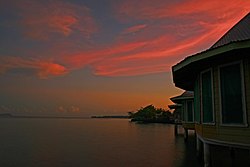Sapapaliʻi
Village in Faʻasaleleaga, Samoa From Wikipedia, the free encyclopedia
Village in Faʻasaleleaga, Samoa From Wikipedia, the free encyclopedia
Sapapaliʻi is a village on the north east coast of Savaiʻi island in Samoa. It is the village where John Williams, the first missionary to bring Christianity to Samoa landed in 1830.[1] Sapapali'i is in the Fa'asaleleaga political district[2] and has a population of 896.[3]
Sapapaliʻi | |
|---|---|
Village | |
 Sunset at Sapapaliʻi | |
| Coordinates: 13°41′21″S 172°11′11″W | |
| Country | |
| District | Faʻasaleleaga |
| Population (2016) | |
| • Total | 896 |
| Time zone | -11 |
Sapapaliʻi became the second Malietoa base in the district in 1750 when Malietoa Tiʻa married a woman from the village. Their son Malietoa Fitisemanu was the father of Malietoa Vaiinupo who received Williams in 1830.[4]
Sapapaliʻi is 8 km north of Salelologa ferry terminal and township.
In the 1970s, Gregory Jackmond carried out archaeological surveys inland from Sapapali'i. Jackmond, a Peace Corps in Samoa, surveyed a 20 hectare area with extensive pre-historic settlements. Jackmond later carried out field work at Palauli on the south east coast where the Pulemelei Mound is situated.[5]
Seamless Wikipedia browsing. On steroids.
Every time you click a link to Wikipedia, Wiktionary or Wikiquote in your browser's search results, it will show the modern Wikiwand interface.
Wikiwand extension is a five stars, simple, with minimum permission required to keep your browsing private, safe and transparent.